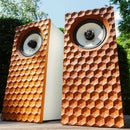Introduction: Beautiful White Oak Floating Corner Shelf
I have been meaning to make a corner shelf in my room for a while.
So it was handy when I came across this scrap piece of gorgeous white oak which was an off cut for a stair case I decided to go for it.
Oh and please vote for me in the shelving contest :)
Step 1: Cleaning Up the Rough Shape
So this piece wasn't perfect when I found it but the sawmill I got it from kindly did a rough sawing of the shape to make the edges square. I just need to refine these edges and round the corners to avoid splintering.
Now I know it is typical to seal the knots in the wood to prevent moisture getting in but I decided against this as it is not worth the trouble for a simple shelf. (also I had run out of epoxy...sue me...)
I will apply a finish that should help protect those knots pictured a bit so there isn't to much concern there.
Step 2: Rounding the First Corner
I decided to round all the sharp corners to prevent any splintering or damage. I started this one with a sharp wood rasp which acts like a very course file and removes lots of material quickly and cleanly.
I then finished it off with some course sand paper and then used a cabinet scraper to produce a smooth finish around the curve.
I then refined the side at the same time with the scraper producing the surface ready for finish to be applied.
Step 3: Next Corner
Again I repeated the process of using the wood rasp followed by sandpaper and the cabinet scraper.
For this one though I used some 400 grit paper to give a very nice finish on this corner because of the sharp angle.
Step 4:
This is the corner that will be in the corner between the walls. This needs a a flat cut into the corner because the corner of the walls it will be mounted to is curved not a perfect sharp corner. I started cutting it with the wood rasp as before but this was very slow progress. I then decided to use a router with a chamfer bit but this didn't take off enough material. Then I made the mistake of using my belt sander with a worn out belt (I didn't realise until after). This ended up leaving the burn marks shown in the picture above. I then just gave up and fixed it all with a chisel.
Step 5: Routing the Edges
Whilst I had the chamfer bit in the router, I went over the edges to give a clean but elegant look to the edge of the shelves. I routed both edges and then went over it with a cabinet scraper. Then some fine sand paper.
Step 6: Cleaning Up the Surface
I used my work bench pegs to hold the shelf in place whilst I scraped the surfaces of the shelf down. I Liked the finish this gave and decided to only touch up the edges with sand paper.
Step 7: Mounting the Floating Shelf
Next I worked on how to make the "floating" aspect of the shelf. I used a dovetail bit to cut slots along the edge of the shelf. I aligned the shelf edge with the edge of my workbench. Then I used this as better platform for the router to keep the router steady. As you can see in the photo the screws I will use to mount it to the wall will grip inside the slots.
The v shape of the slot cut by the router allows the countersink heads of the screws, once screwed into the wall, to wedge into the slots and pull the shelf against the wall clamping it in place. The fact that this is a corner shelf means that you have rigidity in both axis. This technique wouldn't necessarily work on a normal shelf.
Step 8: Test Fit
I put the new shelf on top of the old cheap pine shelf and marked where the holes for the screws needed to go for new shelf. Then I used a masonry bit to drill into the brick walls. I used the trick with a post it to catch the dust from the holes. Then I sued some rawl plugs to put the screws into the wall to mount the shelf. I did a test fit and it was surprisingly secure.
Step 9: Finishing the Oak
Next I removed the shelf and applied a water seal finish to the oak. It isn't as thick as varnish but seals the wood and provides excellent water repellent properties. And brings out the grain in the wood and increases the contrast. It does make it look extremely nice and I was happy with the results.
Step 10: It's Done!
I then re attached the shelf to the wall and checked that it was level. Job done!

Participated in the
Shelving Contest













